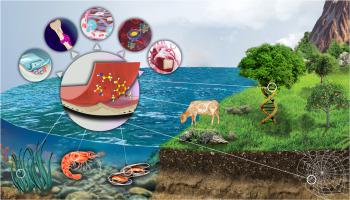当前位置:
X-MOL 学术
›
Prog. Polym. Sci.
›
论文详情
Our official English website, www.x-mol.net, welcomes your
feedback! (Note: you will need to create a separate account there.)
Multifunctional naturally derived bioadhesives: From strategic molecular design toward advanced biomedical applications
Progress in Polymer Science ( IF 26.0 ) Pub Date : 2024-01-26 , DOI: 10.1016/j.progpolymsci.2024.101792 Mahshid Kharaziha , Thomas Scheibel , Sahar Salehi
Progress in Polymer Science ( IF 26.0 ) Pub Date : 2024-01-26 , DOI: 10.1016/j.progpolymsci.2024.101792 Mahshid Kharaziha , Thomas Scheibel , Sahar Salehi

|
In the last decades, adhesives derived from natural resources (i.e., bioadhesives) have emerged as promising alternative to the standard wound closure devices, including sutures, clips, and strips, owing to relatively easy and rapid application, minimal tissue damage, fast hemostasis, and ability to decrease the risk of infection. Various synthetic and natural materials have been utilized as bioadhesives. These materials find extensive applications in various biomedical fields, ranging from simple wound sealing to controlled drug delivery, tissue regeneration, and noninvasive therapy. Considering the weak underwater adhesion, degradability, and biological performances of synthetic adhesives, naturally derived-based adhesives are more attractive. The first generation of these bioadhesives provided primarily only one function. Moreover, they had issues including long curing time, slow adhesion, high degradation rate, low mechanical properties, and the risk of transferring contamination to the wound. Various chemically and genetically engineered strategies have been applied to advance their multifunctionality. The synergy of bonding chemistry, topography, and mechanics of dissipation in their structure supports the improved adhesion and controlled degradation rate. Various naturally derived bioadhesives are developed that cover subjects from innovative biomaterial synthesis or functionalization and cutting-edge manufacturing processes. However, to fulfill all the criteria of an ideal bioadhesive for clinical applications, more efforts should be devoted to investigating the surface characteristics of target tissues and the long-term relationship between the physiochemical properties of natural polymers and cohesion and adhesion mechanisms, as well as adhesive functionality. This review outlines the recent progress on naturally-derived bioadhesives, including proteins and polysaccharides, focusing on designing approaches based on chemically and genetically engineering strategies, development, and applications. Furthermore, the challenges of current studies are summarized to show future perspectives for developing bioengineered and high-performance naturally-derived bioadhesives for clinical use.
中文翻译:

多功能天然生物粘合剂:从战略分子设计到先进生物医学应用
在过去的几十年中,源自自然资源的粘合剂(即生物粘合剂)已成为标准伤口闭合装置(包括缝合线、夹子和条带)的有前途的替代品,因为应用相对容易和快速,组织损伤最小,止血速度快,以及降低感染风险的能力。各种合成和天然材料已被用作生物粘合剂。这些材料在各种生物医学领域有着广泛的应用,从简单的伤口密封到受控药物输送、组织再生和非侵入性治疗。考虑到合成粘合剂的水下粘合力较弱、可降解性和生物性能,天然衍生的粘合剂更有吸引力。第一代生物粘合剂主要仅提供一种功能。此外,它们还存在固化时间长、粘附慢、降解率高、机械性能低以及将污染转移到伤口的风险等问题。各种化学和基因工程策略已被应用于提高其多功能性。其结构中键合化学、形貌和耗散力学的协同作用支持提高粘附力和控制降解速率。开发了各种天然衍生的生物粘合剂,涵盖创新生物材料合成或功能化以及尖端制造工艺的主题。然而,为了满足临床应用理想生物粘附剂的所有标准,应更多地致力于研究目标组织的表面特性以及天然聚合物的理化性质与内聚力和粘附机制之间的长期关系,以及粘合功能。本综述概述了天然来源的生物粘合剂(包括蛋白质和多糖)的最新进展,重点关注基于化学和基因工程策略、开发和应用的设计方法。此外,总结了当前研究的挑战,以展示开发用于临床的生物工程和高性能天然生物粘合剂的未来前景。
更新日期:2024-01-26
中文翻译:

多功能天然生物粘合剂:从战略分子设计到先进生物医学应用
在过去的几十年中,源自自然资源的粘合剂(即生物粘合剂)已成为标准伤口闭合装置(包括缝合线、夹子和条带)的有前途的替代品,因为应用相对容易和快速,组织损伤最小,止血速度快,以及降低感染风险的能力。各种合成和天然材料已被用作生物粘合剂。这些材料在各种生物医学领域有着广泛的应用,从简单的伤口密封到受控药物输送、组织再生和非侵入性治疗。考虑到合成粘合剂的水下粘合力较弱、可降解性和生物性能,天然衍生的粘合剂更有吸引力。第一代生物粘合剂主要仅提供一种功能。此外,它们还存在固化时间长、粘附慢、降解率高、机械性能低以及将污染转移到伤口的风险等问题。各种化学和基因工程策略已被应用于提高其多功能性。其结构中键合化学、形貌和耗散力学的协同作用支持提高粘附力和控制降解速率。开发了各种天然衍生的生物粘合剂,涵盖创新生物材料合成或功能化以及尖端制造工艺的主题。然而,为了满足临床应用理想生物粘附剂的所有标准,应更多地致力于研究目标组织的表面特性以及天然聚合物的理化性质与内聚力和粘附机制之间的长期关系,以及粘合功能。本综述概述了天然来源的生物粘合剂(包括蛋白质和多糖)的最新进展,重点关注基于化学和基因工程策略、开发和应用的设计方法。此外,总结了当前研究的挑战,以展示开发用于临床的生物工程和高性能天然生物粘合剂的未来前景。






























 京公网安备 11010802027423号
京公网安备 11010802027423号